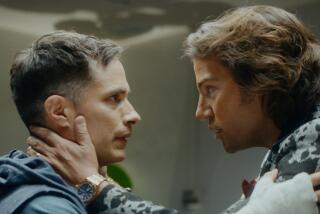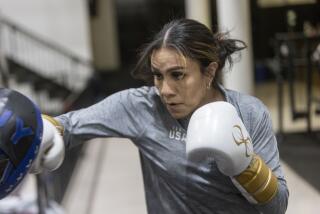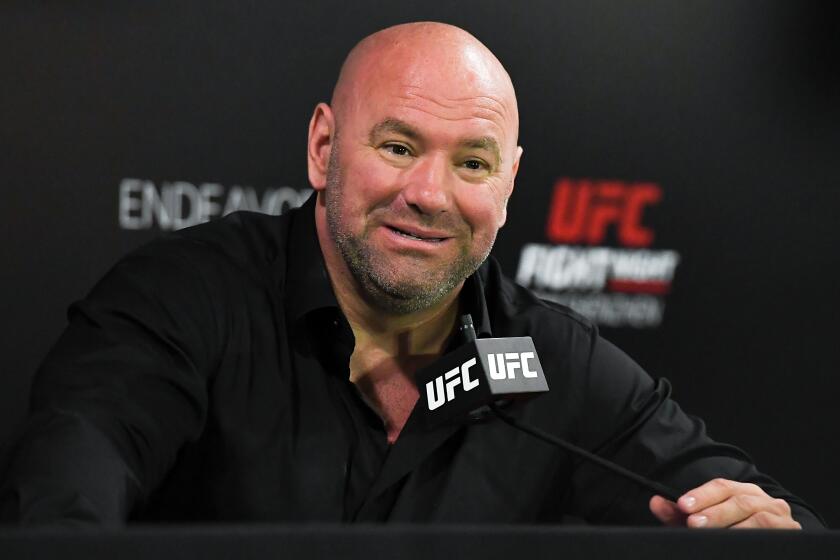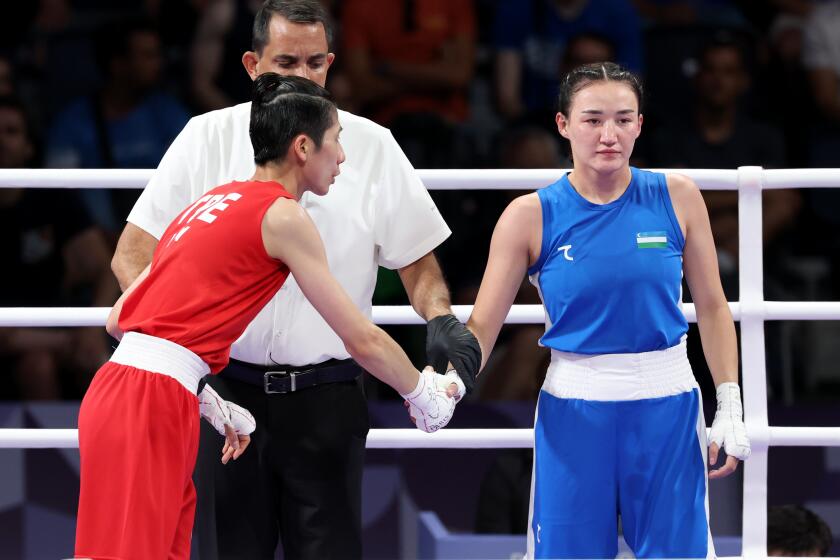Oscar Del La Hoya carried boxing
Oscar De La Hoya spent the first day of the rest of his life making a speech from a lectern that faced across a street at a 20-foot statue of himself.
The Golden Boy, already bronzed, announced his retirement as a boxer Tuesday. This was not so much news as it was inevitability.
He is 36, has had 45 fights, won 10 titles in six weight classes, been on a record 19 pay-per-view fights and a record 32 HBO telecasts, has generated just shy of $700 million in pay-per-view revenue, also a record, and has carried his sport, through thick and mostly thin, for much of his 17 years as a pro fighter.
More important, he has a wife and kids and knows he is reaching the stage where more fights, more blows to the head, can lead more quickly to slurring than to success.
“I want to watch my kids grow up,” De La Hoya said.
Tim Leiweke, a business partner of De La Hoya’s in Golden Boy Promotions, seconded that in his turn at the lectern.
“His wife, Millie, will be glad to get him back,” Leiweke said, “and completely intact.”
Millie Corretjer, Puerto Rican actress and recording star, and Mrs. De La Hoya for the last eight years, said, “I can’t wait for our next eight, and our next eight.”
She said she disliked boxing when she first met De La Hoya.
“But I learned to love it,” she said, “because he loved it so much.”
There was too much pomp and circumstance in the plaza outside Nokia Theatre for this to turn out like so many of those other boxer retirements, which are merely rest periods, awaiting the next big paycheck.
Asked afterward if there had been one big fight that he saw out there that had given him pause in this decision, De La Hoya said, “There are a lot of slow guys left that I could have fought, but the answer is no. If you do that, there will always be a last fight.”
His pro career began Nov. 23, 1992, just months after he won the only United States gold medal in boxing at the Barcelona Olympics. That pro debut, De La Hoya fighting Lamar Williams at 133 pounds, was described by boxing writer Earl Gustkey of The Times:
“Oscar De La Hoya launched his professional boxing career at 9:22 p.m. Monday night at the Forum. By 9:24, he was 1-0 and looking happily to a future more golden than his recent past.”
He won his first title March 5, 1994, against Jimmi Bredahl at the Forum, at 130 pounds. And he didn’t lose until Sept. 18, 1999, or 31 fights into his career, when he took a big lead and then tired and coasted at the end against Felix Trinidad, who was awarded a controversial decision.
He eventually lost twice to Shane Mosley and once to Bernard Hopkins, both of whom are now among his business partners at Golden Boy. He fought Floyd Mayweather Jr. in his only match of 2005, a close decision that, while De La Hoya lost, attracted the largest pay-per-view audience ever at 2.4-million buys and left plenty of interest for the huge Dec. 6 promotion last year that matched De La Hoya and Manny Pacquiao at 147 pounds.
That fight ended with a battered De La Hoya walking across the ring before the ninth round to shake Pacquiao’s hand and tell his friend and Pacquiao’s trainer, Freddie Roach, that he didn’t have it anymore.
On Tuesday, after his retirement speech, De La Hoya said, “I can thank Manny Pacquiao for what he did to me. He showed me it was over.”
Even though it took him four months to make that official, those who watched closely on that final December night, when friend and business partner Richard Schaefer and wife Millie begged his trainer a round earlier to stop the fight, knew De La Hoya would not fight again.
“I understand why athletes have such a hard time retiring,” De La Hoya said in his speech. “You always think you can do it one more time.”
So did Muhammad Ali, the late Jerry and Mike Quarry, even Freddie Roach himself, all affected neurologically, at least in part, by too many punches to the head.
“I promised myself, my family, everybody, that this is it,” De La Hoya said.
The legendary George Foreman said the same thing 16 years ago, only about De La Hoya. HBO executive Mark Taffet told the story of being on a train during a whistle-stop promotion for the Foreman-Tommy Morrison fight. He said Foreman pointed to the front of the train, at a young De La Hoya, along to fight on the undercard.
“See that kid up there,” Foreman said. “That’s the future of boxing.”
For boxing, that was a passage.
Tuesday, in a big plaza in the entertainment center of a big city, with more than 40 cameras on tripods snapping away from risers, with microphones and pads and pencils everywhere, and a giant TV screen looming overhead, there was another.
--
More to Read
Go beyond the scoreboard
Get the latest on L.A.'s teams in the daily Sports Report newsletter.
You may occasionally receive promotional content from the Los Angeles Times.











